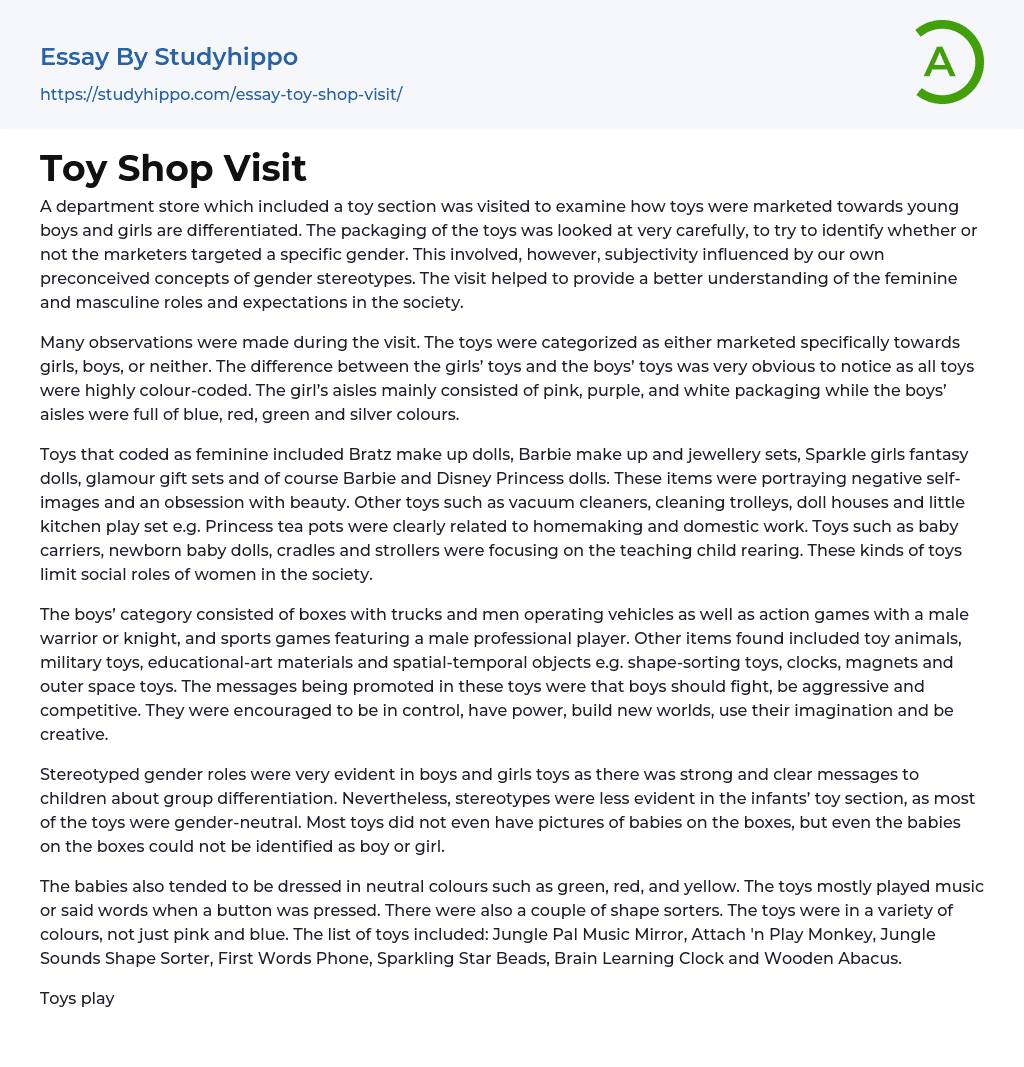A department store which included a toy section was visited to examine how toys were marketed towards young boys and girls are differentiated. The packaging of the toys was looked at very carefully, to try to identify whether or not the marketers targeted a specific gender. This involved, however, subjectivity influenced by our own preconceived concepts of gender stereotypes. The visit helped to provide a better understanding of the feminine and masculine roles and expectations in the society.
Many observations were made during the visit. The toys were categorized as either marketed specifically towards girls, boys, or neither. The difference between the girls’ toys and the boys’ toys was very obvious to notice as all toys were highly colour-coded. The girl’s aisles mainly consisted of pink, purple, and white packaging while the boys’ aisles were full of bl
...ue, red, green and silver colours.
Toys that coded as feminine included Bratz make up dolls, Barbie make up and jewellery sets, Sparkle girls fantasy dolls, glamour gift sets and of course Barbie and Disney Princess dolls. These items were portraying negative self-images and an obsession with beauty. Other toys such as vacuum cleaners, cleaning trolleys, doll houses and little kitchen play set e.g. Princess tea pots were clearly related to homemaking and domestic work. Toys such as baby carriers, newborn baby dolls, cradles and strollers were focusing on the teaching child rearing. These kinds of toys limit social roles of women in the society.
The boys’ category consisted of boxes with trucks and men operating vehicles as well as action games with a male warrior or knight, and sports games featuring a male professional player. Other items found included toy
animals, military toys, educational-art materials and spatial-temporal objects e.g. shape-sorting toys, clocks, magnets and outer space toys. The messages being promoted in these toys were that boys should fight, be aggressive and competitive. They were encouraged to be in control, have power, build new worlds, use their imagination and be creative.
Stereotyped gender roles were very evident in boys and girls toys as there was strong and clear messages to children about group differentiation. Nevertheless, stereotypes were less evident in the infants’ toy section, as most of the toys were gender-neutral. Most toys did not even have pictures of babies on the boxes, but even the babies on the boxes could not be identified as boy or girl.
The babies also tended to be dressed in neutral colours such as green, red, and yellow. The toys mostly played music or said words when a button was pressed. There were also a couple of shape sorters. The toys were in a variety of colours, not just pink and blue. The list of toys included: Jungle Pal Music Mirror, Attach 'n Play Monkey, Jungle Sounds Shape Sorter, First Words Phone, Sparkling Star Beads, Brain Learning Clock and Wooden Abacus.
Toys play a vital role in the development of children and are very essential to healthy child development. They are an important source of education for young children. However, gender specific toys which are targeted at children at a very early age are deeply restricting and severely limit the development of boys and girls in different ways. It was found that playing with feminine toys fosters nurturance, proximity and role play, while playing with masculine toys leads to higher mobility, activity
and manipulative play. While linked to the public sphere, men will continue to have a higher status than women as they have more power and control over the women.
Since more gender-specific toys have been introduced to young children, the existence of gender bias has been highly conspicuous in our society. It is widely accepted that children play with toys that has long-term consequences for later development. In particular, girls get to play with toys that are clearly linked to the private sphere while boys’ toys are related to the public sphere. Unfortunately, sexism in society is exposed through children’s toys which are highly stereotyped. A resolution for this is to allow children play to choose their own toys and introduce them more to the gender-neutral toys.
Toys are vital tools that help foster the mental, physical, emotional and social development of boys and girls. Toys are basic instruments for the development of children’s fantasy, thoughts and creativity.
Outdoor baby toys support the right to play in childhood which is essential to healthy child development. Children gain a strong foundation for learning through play. Playtime is fun. Young children love to explore and discover new things about the world around them and about themselves.
- Baby Clothes essays
- Social Construction of Gender essays
- Wall Street essays
- Dead Poets Society essays
- A beautiful mind essays
- Sherlock Holmes essays
- Our day out essays
- American Beauty essays
- Do The Right Thing essays
- Forrest Gump essays
- Good Will Hunting essays
- Finding Forrester essays
- Looking For Alibrandi essays
- On The Waterfront essays
- One Flew Over The Cuckoo'S Nest essays
- Rabbit Proof Fence essays
- Remember The Titans essays
- Schindler'S List essays
- Shawshank Redemption essays
- The Blind Side essays
- Titanic essays
- Witness essays
- The Veil essays
- Blade Runner essays
- Monster essays
- The Graduate essays
- Twilight essays
- West Side Story essays
- Like Water For Chocolate essays
- Glory essays
- Superman essays
- Moulin rouge essays
- American Films essays
- Cinema Of The United States essays
- English-Language Films essays
- Film Editing essays
- Film Noir essays
- Film Techniques essays
- Horror essays
- Bollywood essays
- The time essays
- Saving private ryan essays
- The hunger games essays
- Comedies essays
- Gattaca essays
- King kong essays
- Melodrama essays
- Resident essays
- Subject matter essays
- The blind essays




